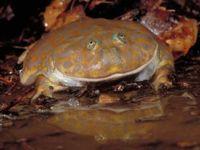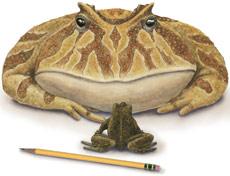Devil Frog Discovered
Posted by: Loren Coleman on February 19th, 2008

The illustration depicts the ancient frog species Beelzebufo, or “devil frog,” staring down what the National Geographic says is the largest frog species living in Madagascar today. Actually, it looks more like a common toad to me. Today, the largest living Madagascar frog is just 4 in (10 cm) long. The world’s largest frog is the African Goliath frog (Conraua goliath) from central Africa: 13 in (33 cm) in body length (legs excluded), and weighs up to 7 lb (3 kg).
A pencil is included for scale as apparently pencils did not exist 70 million years ago.

Evidence of a giant frog found in Madagascar has led researchers to speculate that an ancient land bridge may have connected the island off southern Africa with South America.
Beelzebufo, or the “devil frog,” was 16-inch (40 cm) long and probably weighed around 5 kg (11 lb)! The fossil frog lived 65 million to 70 million years ago during the Cretaceous Period, during the last 5 million years of dinosaur existence, according to researchers from the University of California Los Angeles and Stony Brook University in New York.

It’s size rivalling a beach ball, the frog was a fierce predator, capable of eating small animals and perhaps even dinosaurs that had just hatched.
About Loren Coleman
Loren Coleman is one of the world’s leading cryptozoologists, some say “the” leading living cryptozoologist. Certainly, he is acknowledged as the current living American researcher and writer who has most popularized cryptozoology in the late 20th and early 21st centuries.
Starting his fieldwork and investigations in 1960, after traveling and trekking extensively in pursuit of cryptozoological mysteries, Coleman began writing to share his experiences in 1969. An honorary member of Ivan T. Sanderson’s Society for the Investigation of the Unexplained in the 1970s, Coleman has been bestowed with similar honorary memberships of the North Idaho College Cryptozoology Club in 1983, and in subsequent years, that of the British Columbia Scientific Cryptozoology Club, CryptoSafari International, and other international organizations. He was also a Life Member and Benefactor of the International Society of Cryptozoology (now-defunct).
Loren Coleman’s daily blog, as a member of the Cryptomundo Team, served as an ongoing avenue of communication for the ever-growing body of cryptozoo news from 2005 through 2013. He returned as an infrequent contributor beginning Halloween week of 2015.
Coleman is the founder in 2003, and current director of the International Cryptozoology Museum in Portland, Maine.










I hope some cryptid explorer can come up with a living specimen.
What would keep a small animal from clawing its way out once eaten?
hey loren thats a huge frog. thanks bill 🙂
It’s a good thing they didn’t have beauty contests 70 million years ago either. That’s a face only a mother could love. Seriously, though, I am very interested in amphibians so this is quite an interesting find to me. I can’t see any good reason why there couldn’t be frogs or toads even bigger than the African goliath frog out there still waiting to be discovered. Are there any credible cryptids of this nature currently out there? Has that frog in Madagascar actually been discovered or is there merely evidence of its presence?
There is the Sapo de Loma from South America, said to be even larger than the Goliath, and Jonathan Downes reported encountering a frog with a bioluminescent spot on its nose being sold at a pet trade show some years back.
And then there is the report of the giant greyish-white toads from Hubei Province, China witnessed by scientists from Beijing University. They were described as emitting horrific cries from their 6-foot-long mouths before one of them devoured their camera equipment, snatching it up with a long tongue. Not sure I buy that report though…
Welsh mythology includes the Llamhigyn y Dwr, a huge toad with no hind legs that sports a long tail and wings. It is also said to produce a frightening shriek. If it ever was a cryptid, it is almost certainly extinct now. Again, it’s another example I’d take with a good helping of salt…
WHOA!!! THat’s a mighty BIG frog!!!
Seriously, though, I DO agree with MYSTERY_MAN. There is no telling what could be out there.
Mnynames- Thanks for the info! I had never heard of those before. Very interesting stuff. I’d be glad to hear of any more you know of.
Speaking of giant amphibians, I have actually done field research concerning Japanese Giant salamanders as well as the Chinese variety that is considered an invasive species here, and they are something else. You really have to see them to believe how enormous they are. I think some cryptid reports that aren’t immediately identified as amphibians could very well be sightings of giants such as these frogs and salamanders. The reports of “black crocodiles” in some areas, for example, immediately bring to mind some type of giant salamander. Who knows, maybe even Nessie has large amphibians behind some sightings? Interesting to speculate about.
Cool topic.
Darren Naish once wrote on his first blog about prehistoric giant frogs (or better said their abscence in fossil records) and the pros and cons against the biological existence of giant frogs and toads. What would be perhaps most interesting about this species is the date of extinction. Did it die out at the end of the cretaceous together with the dinosaurs and many other animals on Madagascar, or did it survive? Madagascar was home to many extremely strange creatures which were still alive only some hundred years ago like the elephant birds, giant lemurs of pygmy hippos.
Well, the absence of a fossil record is not that surprising to me. The fossilization process is pretty rare to begin with and amphibian fossils are especially so. Madagascar is a fascinating place for strange animals for sure. It has a very unique ecosystem and evolutionary history. Like the Galapagos and Australia, it offers many good examples of creatures that have uniquely evolved in relative isolation. Many animals there are found no where else on Earth. I highly doubt we are done with seeing the interesting and sometimes bizarre animals to be found there, and I think it is a very good place for future study.
Yes, we are only roughly 500-1000 years too late. The best things we can still discover there are most probably lemurs, although there were rumours of pygmy hippos surviving into the 20th century, as well as surviving giant fossas, big lemurs and the giant aye-aye Daubentonia robusta.